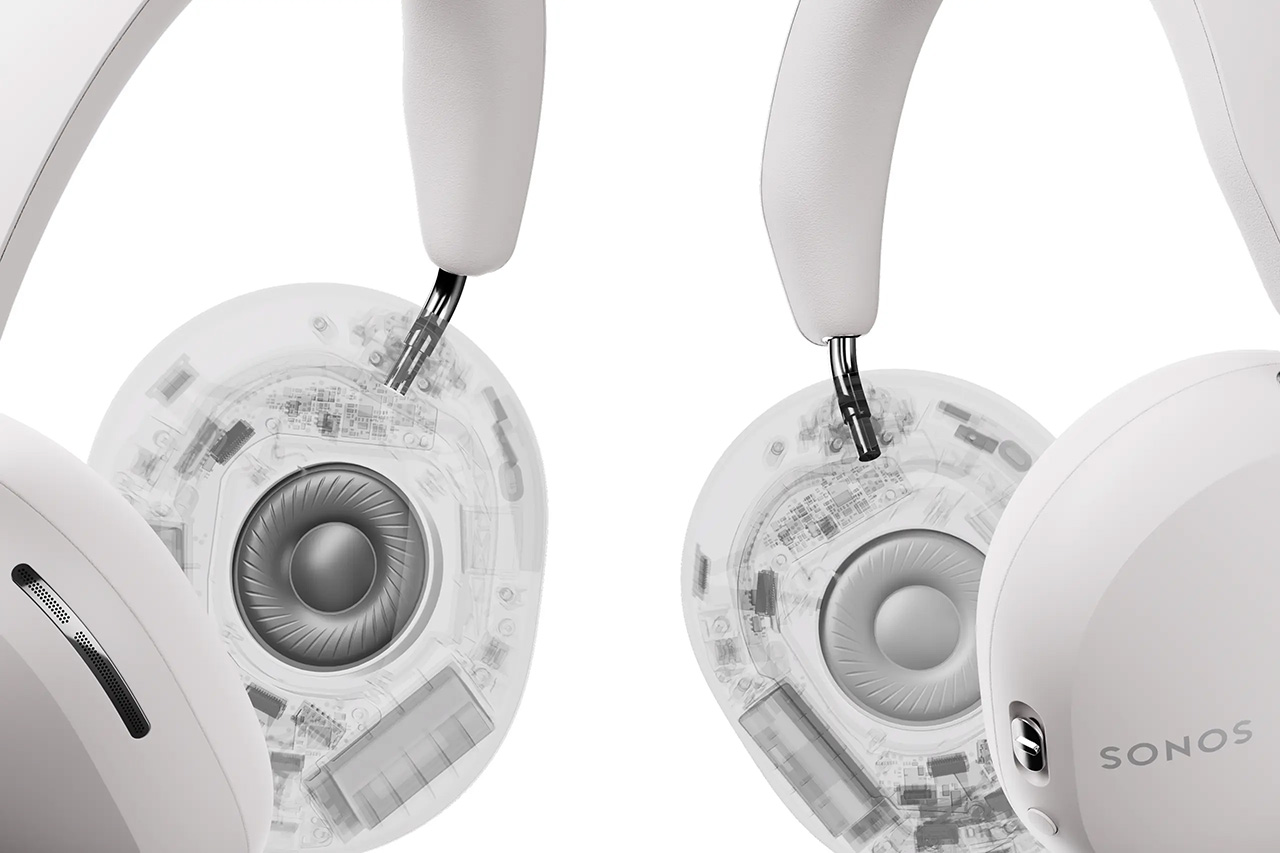The Sonos Ace design story begins with Marcel Breuer’s Wassily Chair. Representing an idealized balance between contrasts – soft with hard, simple and complex, machined versus the human body – the iconic Bauhaus modernist design offered the Sonos design team a perfect aesthetic and functional template for designing what would become the brand’s first headphones. Across the Wassily Chair, hard, shiny metal is tasked for structural support while soft and supple leather is assigned to offering a comfortable touch point (vegan leather, in the case of the Ace). While no one sets out to wear a chair on their head, the parallels between the Sonos Ace’s clean lines and subtle angled profile are evident across its combination of contrasting materials. We spoke with Aki Laine, Sonos’ Director of Industrial Design about some of the individual details that together results in what he believes makes the Sonos Ace headphones a unique entry in the competitive field of ANC headphones.
Inclusive Comfort at its Core
From the outset, the Sonos design team identified a comfortable fit as essential. According to Laine the shape of the Ace ear cups are the result of extensive ergonomic research. “We did research comfort testing with nearly 600 participants, representing a range in age, gender, different head sizes and shapes, ear sizes, earrings versus no earrings. We even tested the Ace with scarves, glasses, and with different hair lengths.”
“If you look at the end cap of the Sonos Arc and the Sonos Move from the top, you can see the same profile, resulting in a nice parity to the Sonos portfolio,” explains Laine. “But this wasn’t the reason why we pursued this particular profile. After testing multiple different designs and prototypes and extensive research, we found out that this shape is really the most optimal shape to create an effective seal around the ear.”

A replaceable mesh basket magnetically clips onto the Ace’s angled driver, following the contour of the ear, ensuring that the ear never comes into contact with the internal components. Note, each side is colored differently; alongside the front angled arms, the differentiation allows users to quickly identify which way to wear the Ace.
The overall user interface language of the Sonos Ace abides by a commitment to tactile simplicity. Physical buttons give users the ability to switch listening modes and volume without the touch-tap guesswork plaguing other headphones, each placed strategically across a section of the headphone’s Laine describes as the “waistline.” In hand, the section adds a defining detail, along with a pleasurable touchpoint.
“We added the waistline to give the overall soft form a little bit of more definition, but also to create this nice landing strip for the hardware UI, microphones, and venting across the front and bottom,” said Laine while leaning into the camera with an early production Ace in hand to show another detail. “We designed these grills for the microphones, and went through several different perforation patterns.”

In person the grills are impressively minute in scale, perforation so small they’re easily overlooked. “They’re chemically etched onto the stainless steel grill and have been designed to ensure that the pattern eliminates any kind of wind noise to create the best possible ANC experience.”

The color palette for the headphones was chosen with inclusivity in mind. The team tested various shades and settled on a soft white and a black, both of which are designed to complement a wide range of skin tones and personal styles. The soft white variant, in particular, features naturally polished metal parts that add a touch of elegance and contrast.
Returning to the controls, Laine expands upon the importance of physical buttons rather than touch capacitive controls to reduce the cognitive load of a device often operated while moving and without the aid of sight.
“We aim to design hardware user interface that is predictable, memorable, and intuitive,” pointing toward a slide dial control Sonos calls the Content Key, Laine rationalizes the mechanical switch+button combination as a proven means of delivering tactile precision between user and device. It is an interesting detail noting the brand’s Era speaker family, alongside the Move, are equipped with a touch capacitive controls, albeit with a slim, shallow physical channel that cues user’s fingers to trace its length. Laine attributes the difference between two different use cases, with the Ace requiring a higher degree of operational confidence clarified by our fingertips.

A hidden hinge mechanism keeps to the minimalist ethos while also adding a moment of metallic elegance evocative of Marcel Breuer’s Wassily Chair. The mechanism purportedly also minimizes the chance of hair snags.

The Misty Green color accent used within the right ear cup of the Soft White Sonos Ace colorway is also applied inside of the case.
Sustainability and Material Choice
Continuing the brand’s efforts to improve in the sustainability department, the headphones are made from 17% post-consumer recycled plastic, with the carrying case made from 75% post-consumer recycled polyester felt. This brings up the question, “Why only 17%?”
“We have very a high durability and quality bar for any product that we ship. Under all the wear, tear, and tension headphones must endure, we identified we would need to incorporate more virgin plastic to meet and exceed the customer expectations.
The California-based brand has earned legions of customers by simplifying the audiophile experience defined less from specs and more shaped by experience. Comparable to Apple, Sonos deliberately designs devices that can be used independently, but only reveal their full potential when used within the brand’s conscientiously developed ecosystem (e.g. the Ace offers a nifty audio output handover option only when paired with the brand’s Arc soundbar). But unlike its network speakers, the Sonos Ace is joining an already crowded field of top tier headphones such as the Apple AirPod Max, Bose QuietComfort Ultra, and Sony WH-1000XM5. In our opinion the Ace’s combination of top performing active noise cancellation, modern aesthetic, and commitment to tactile controls is deserving of attention… and a listen.
For more information or to purchase the Sonos Ace headphones, head to sonos.com.
This post contains affiliate links, so if you make a purchase from an affiliate link, we earn a commission. Thanks for supporting Design Milk!





